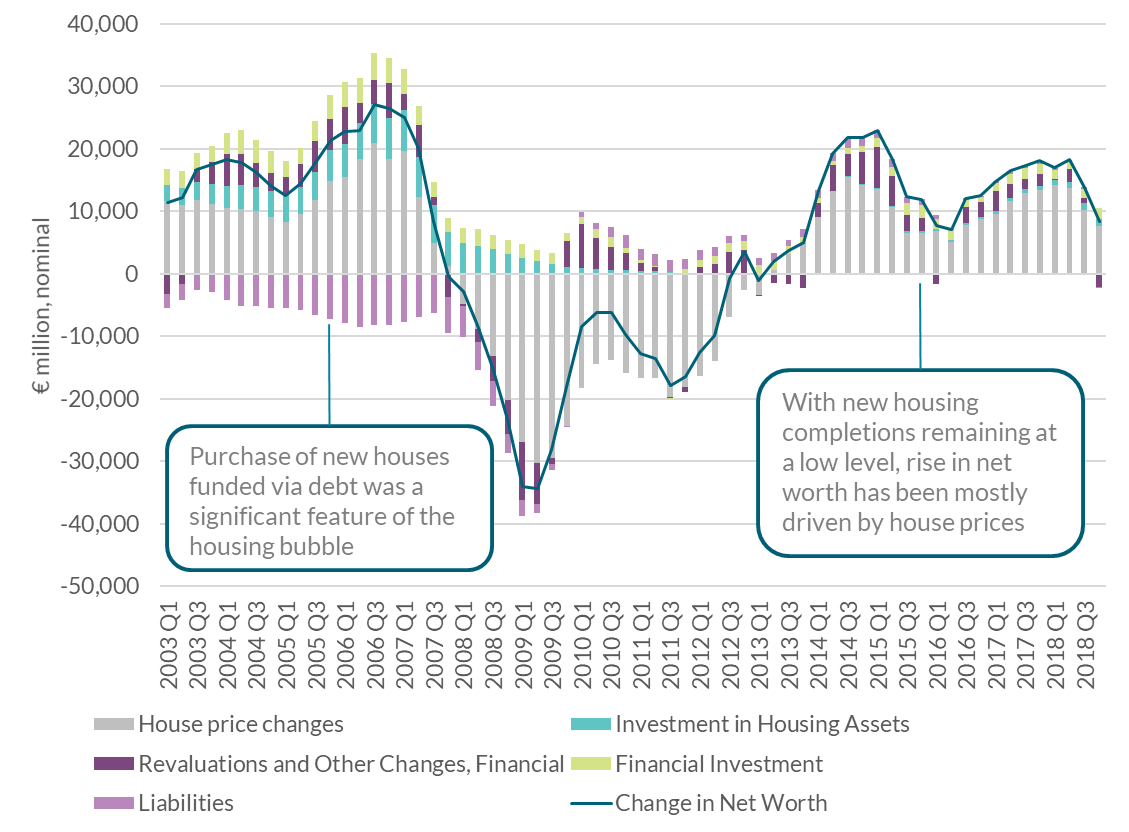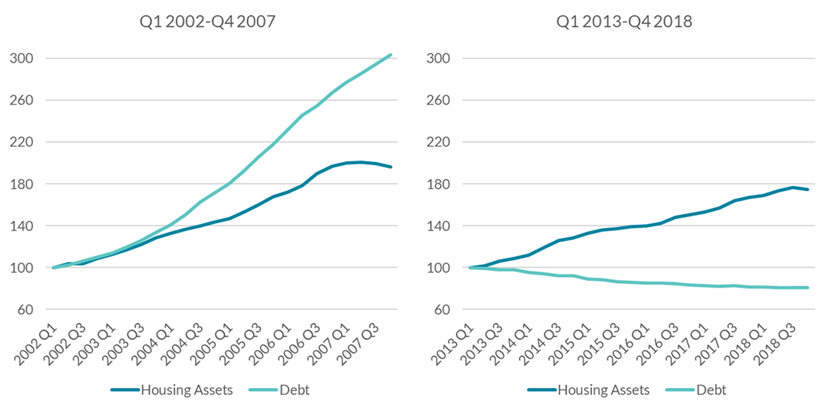Behind the Data

A New High in Irish Household Wealth: What is Different this Time?
Faris Bader and Cormac O'Sullivan
June 2019
The wealth of the Irish household sector has surpassed the pre-crisis peak. This recovery, outlined in recent Quarterly Financial Accounts, primarily reflects developments in house prices, the accumulation of financial assets as well as the considerable deleveraging that followed the financial crisis.
The Data
To examine the dynamics behind the increase in household wealth, we combined the financial balance sheet for the household sector (from the Central Bank of Ireland Quarterly Financial Accounts) with estimates of the value of housing assets. This"Behind the Data" note looks at the longer-term trends in household wealth – as measured by net worth – and the factors underlying it. We also compare the recovery period of growth with the previous period that ended with the financial crisis, highlighting the contrasting role played by household debt.
Household net worth comprises the holdings of financial assets – such as bank deposits or holding of shares – plus the value of the housing stock owned by households, less liabilities – such as mortgages and consumer debt.
While net worth of the Irish household sector as a whole is now greater than at the height of the housing bubble (Chart 1), wealth on a per household basis has not fully recovered. This is due to an increase in the number of households, which have increased from 1.65 million in 2011 to 1.7 million in 2016. Average household net worth peaked at €477,226 in 2007, before falling to €258,047 in 2013. The most recent estimates for end-2018 give a net worth per household of €440,059.
Chart 1: Household net worth has exceeded the 2007 peak

The Drivers of the Changing Net Worth
It is possible to break down the change in household net worth into:
- Changes in the value of existing assets and liabilities
- Investment (or disinvestment) in financial or housing assets
- The incurrence (or repayment) of liabilities.
Chart 2 highlights the dominant role played by house prices in driving overall changes in net worth. The house price gains pre-crisis drove the gains in wealth. This exposure to house price developments was reinforced by additional investment in new housing with growing debt used to leverage the exposure to the housing market. The subsequent fall in house prices from 2007 sharply eroded household wealth during the crisis. The gradual rebound in wealth post crisis was again driven by house price gains. While wealth held in housing has recovered strongly as a result, it is still 12 per cent below where it was in 2007 reflecting the fact that prices are still 18 per cent below their pre-crisis peak. Valuation changes on financial assets are much more volatile over time, reflecting the impact of global equity market movements on direct share holdings as well as their indirect holdings via pension and insurance portfolios.
Chart 2: House price changes are the main driver of the change in net worth

Investment in housing assets contributed strongly to growth up to 2007, but has contributed little since. When a house is sold from one resident household to another, there is no change in the net worth of the Irish household sector, as the transaction is between two parts of the same sector. Investment in housing assets therefore represents purchases of new houses. While housebuilding added significantly to household wealth in the period 2003-2008, albeit accompanied by large increases in debt, thus far this has not been a significant feature of the recovery. On the other hand, investment in financial assets has been relatively stable throughout the period since 2002, with households steadily adding to their deposit savings and their longer-term pension and life insurance assets.
This Time it’s Different: Debt and Deleveraging
To highlight the different drivers between the periods before and after the financial crisis, we indexed asset and liabilities for the periods 2002-2007 and 2013-2018. While the growth of net worth in both periods was primarily driven by increasing house prices, the contribution of debt was very different. In the period leading up to the financial crisis, house price growth was accompanied by a large increase in debt as households took on debt rapidly in order to fund the house purchases. Over the five-year period to Q4 2007, household debt more than trebled in size. In contrast, the more recent data for the period 2013-2018 show that growth in the value of housing assets has been decoupled from growth in debt, as households have continued to deleverage. Active deleveraging by households has reduced the debt burden by €43 billion over the last ten years, while the ratio of household debt to disposable income has fallen to 123.5 per cent, the lowest level since 2003.
Chart 3: Marked difference in trends in debt between pre- and post-financial crisis periods

Household leverage – measured as the ratio of debt to total assets – is at levels last seen in 2003. This places households’ wealth on a more sustainable footing and less susceptible to changes in asset prices than in comparison to 2007. Nevertheless, there are still risks. The latest Quarterly Financial Accounts show the first increase in household debt to asset ratio since 2013, and the Macro-Financial Review highlighted that residential real estate valuations are close to or above what would be consistent with broader economic developments.
Total household wealth reached the highest level ever in 2018. On the face of it, this is a noteworthy recovery from the lows experienced during the financial crisis. However, there are distributional differences in household wealth and residual financial stress from the crisis period. For example, one in every 17 mortgages are still in arrears over 90 days. In addition, increases (or decreases) in wealth arising from house prices changes may accrue to a narrower group in the future, as homeownership has decreased slightly in recent years. Home ownership across most age groups has declined since 2011, with the decline particularly noticeable in the younger cohorts. Due to the cyclical nature of house prices, the timing of a house purchase will also be an important factor in determining the wealth of any individual household.
When analysing the data on household wealth, whether from a financial stability, macroeconomic or social perspective, understanding the distribution is key. This is an important area of ongoing work at the Central Bank and for the future evolution of the European Financial Accounts framework. The second wave of the Household Finance and Consumption Survey, due later this year, will also provide crucial evidence on the economic recovery and how it has affected different types of households.
See also
"Behind the Data: The Who's Who of Irish Collateralised Loan Obligations"